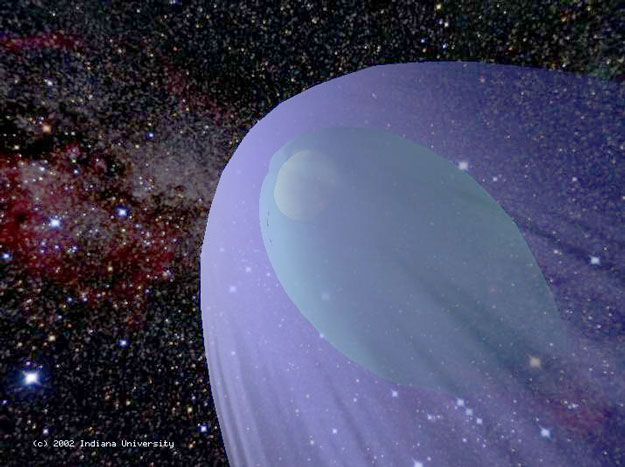
|
Explanation: Where does the Sun's influence end? Nobody is sure. Out past the orbits of Neptune and Pluto extends a region named the heliosphere where the Sun's magnetic field and particles from the Solar Wind continue to dominate. The surface where the Solar Wind drops below sound speed is called the termination shock and is depicted as the inner oval in the above computer-generated illustration. It is thought that this surface occurs as close as 75-90 AU -- so close that a Pioneer of Voyager spacecraft may soon glide though it as they exit the Solar System at about 3 AU/year. The actual contact sheet between the Sun's ions and the Galaxy's ions is called the heliopause and is thought to occur at about 110 AU. It is depicted above as the middle surface. The Sun's heliopause moves through the local interstellar medium much as a boat moves on water, pushing a bow shock out in front, thought to occur near 230 AU.
|
January February March April May June July August September October November December |
| ||||||||||||||||||||||||||||||||||||||||||||||||
NASA Web Site Statements, Warnings, and Disclaimers
NASA Official: Jay Norris. Specific rights apply.
A service of: LHEA at NASA / GSFC
& Michigan Tech. U.
Based on Astronomy Picture
Of the Day
Publications with keywords: Sun - Heliosphere - Heliopause
Publications with words: Sun - Heliosphere - Heliopause
See also:
- APOD: 2025 March 16 Б Venus and the Triply Ultraviolet Sun
- APOD: 2024 September 2 Б A Triangular Prominence Hovers Over the Sun
- APOD: 2024 August 18 Б A Solar Prominence Eruption from SDO
- APOD: 2024 August 4 Б Gaia: Here Comes the Sun
- APOD: 2024 July 28 Б Sun Dance
- Prominences and Filaments on the Active Sun
- APOD: 2024 May 28 Б Solar X Flare as Famous Active Region Returns
